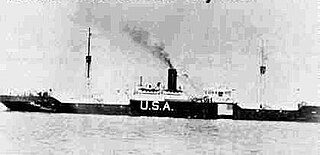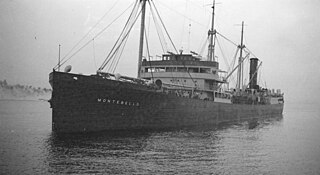
RMS Laconia was a Cunard ocean liner, built by Swan, Hunter & Wigham Richardson as a successor of the 1911–1917 RMS Laconia. The new ship was launched on 9 April 1921, and made her maiden voyage on 25 May 1922 from Southampton to New York City. At the outbreak of the Second World War she was converted into an armed merchant cruiser, and later a troopship. She was sunk in the South Atlantic Ocean on 12 September 1942 by U-156. Some estimates of the death toll have suggested that over 1,658 people were killed when the Laconia sank. Hartenstein staged a rescue of the passengers and the crew of Laconia, which involved additional German U-boats and became known as the Laconia incident.
HMS Audacity was a British escort carrier of the Second World War and the first of her kind to serve in the Royal Navy. She was originally the German merchant ship Hannover, which the British captured in the West Indies in March 1940 and renamed Sinbad, then Empire Audacity. She was converted and commissioned as HMS Empire Audacity, then as HMS Audacity. She was torpedoed and sunk by a German U-boat in late 1941.

The first USS Amphion was a former German passenger liner SS Köln for Norddeutscher Lloyd from 1899–1917. Köln had been interned in Boston on the outbreak of war in Europe and confiscated in April 1917 when the United States entered the war. The ship was under the control of the United States Shipping Board (USSB) that allocated commercial type ships to military or civilian use during the war. Köln was renamed Amphion and operated by USSB for the Army as United States Army Chartered Transport (U.S.A.C.T.) Amphion as an animal transport taking mules, horses and general cargo to forces in Europe. At the end of the war the USSB allocated the ship to the Navy, which used the ship from April to September 1919 as a troop transport for returning the United States Expeditionary Force from Europe.

USS Newport News (AK-3) was a cargo liner that was launched in Germany in 1903 as St. Jan. She was renamed Odenwald in 1907 when she changed owners, and Newport News in 1917 when the United States seized her. She was renamed Arctic in 1925, and scrapped in 1937.

SS Robin Moor was a United States cargo steamship that was built in 1919 and sunk by a German U-boat in May 1941, several months before the US entered World War II.

MV Spreewald was a Hamburg America Line (HAPAG) cargo motor ship that was launched in 1922 and sunk in a friendly fire incident in 1942. She was renamed Anubis in 1935, and reverted to her original name Spreewald in 1939.
SS Manistee was an Elders & Fyffes Ltd banana boat that was launched in 1920. She was one of a numerous class of similar banana boats built for Elders & Fyffes in the 1920s.
SS Dundee was a British steamship that was built in Scotland in 1911 and sunk by enemy action in the Celtic Sea in 1917. She was designed as a coastal passenger and cargo liner for the Dundee, Perth & London Shipping Company Ltd, but in 1915 she was converted into an armed boarding steamer for the Royal Navy. She took part in the Action of 16 March 1917, was sunk by a U-boat six months later, and lost members of her crew in both actions.

Montebello was a steam oil tanker built in 1920–1921 by the Southwestern Shipbuilding Co. of San Pedro for Union Oil Company. It was designed to carry oil and petroleum products along the West Coast of the United States and Canada, as well as between the United States and Chile. In December 1941 the tanker was sunk on one of her regular trips by the Japanese submarine I-21.
SS Louise Lykes was a Type C2-F ship built in 1941 at Federal Shipbuilding of Kearny, New Jersey. She sailed for the Lykes Brothers Steamship Company out of New Orleans, Louisiana. On 9 January 1943, she was sunk with all hands in the North Atlantic by U-384.
SS Fairport was a Type C2-S-E1 cargo ship built by Gulf Shipbuilding for the Waterman Steamship Company. She was sunk by U-161 on 16 July 1942. All hands were rescued by an American destroyer.
SS Express was a Type C3-E cargo ship of American Export Lines that was sunk by I-10 in June 1942 in the Indian Ocean. The ship, built in 1940 by Bethlehem Shipbuilding in Quincy, Massachusetts, was one of eight sister ships built for the United States Maritime Commission on behalf of American Export Lines. Out of a total of 55 men aboard the ship at the time of its torpedoing, 13 were killed; most of the other 42 landed on the coast of Mozambique six days after the sinking.
MV Dumana was a British cargo liner that was laid down as Melma, but launched in 1921 as Dumana. The British India Steam Navigation Company (BI) owned her, and ran her on routes between London and India.

German submarine U-126 was a Type IXC U-boat of Nazi Germany's Kriegsmarine during World War II. In six patrols, she sank 25 ships for a total of 111,564 gross register tons (GRT) and 450 tons. She was laid down at the DeSchiMAG AG Weser yard in Bremen as yard number 989 on 1 June 1940, launched on 31 December and commissioned on 22 March 1941 under Kapitänleutnant Ernst Bauer.
SS Maasdam was a Dutch turbine steamship that was launched in 1920 and sunk in 1941. She was the third Holland America Line ship to be named after the village of Maasdam in South Holland.
USCGC Acacia (WAGL-200) was originally built for service by the U.S. Army as a mine planter shortly after World War I and later transferred to the U.S. Lighthouse Service, which became part of the U.S. Coast Guard in 1939; when transferred the ship was redesignated as a Speedwell-class buoy tender. She was sunk in 1942 by a German U-boat.

Cardina was a cargo ship built in 1919 by the J. F. Duthie & Company of Seattle. She was one of the many ships built by the company for the United States Shipping Board.
HMS Crispin was a British cargo steamship that was launched in England in 1934 and operated by Alfred Booth and Company between Liverpool and the east coast of South America. In 1940 the British Admiralty requisitioned her and had her converted into an ocean boarding vessel. In 1941 a U-boat sank her in the Battle of the Atlantic, killing 20 of her crew.
USAT Sicilien was the Danish motor vessel MS Sicilien built in 1938. After Germany occupied Denmark 9 April 1940 Danish ships were considered enemy ships by Britain and France and subject to seizure. Sicilien was one of forty that sought refuge in the neutral United States. On 30 March 1941 those ships were seized by the United States and requisitioned on 23 July 1941. The ship was then turned over to the United States Army for operation as a United States Army Transport.

SS Torrington was a British cargo steamship that was built in England in 1905, owned and registered in Wales, and sunk by a German U-boat in 1917. She was a turret deck ship: an unusual hull design that was developed by William Doxford & Sons of Sunderland in the 1890s.








